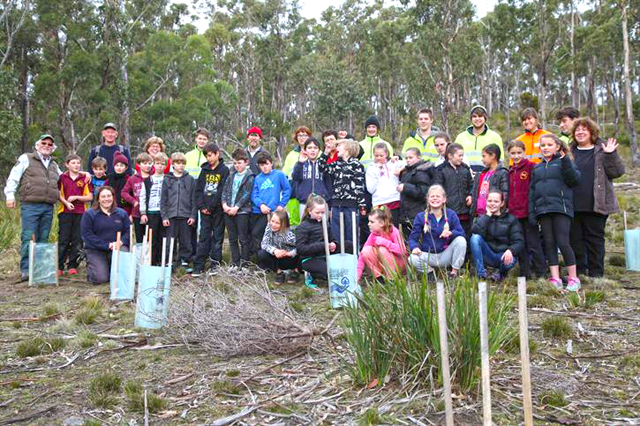How schools are stepping in where public discourse has failed

Snug Primary students during a day exploring the Conningham Nature Recreation Area. PHOTO Tasmanian Parks & Wildlife Service
In September, carbon dioxide levels in the air are at their annual minimum. For the first time in human history, last month they stayed above 400 parts per million, making it all but certain that no-one alive today will ever again see CO2 below that symbolic mark.
We don’t yet have September global surface temperature data, but August produced the 16th successive monthly heat record and 2016 now seems certain to become the warmest year – the third year in a row to break the record.
Meanwhile, one-in-50- or 100-year weather events are happening often enough to question the point of such names.
Yet in Australia the public response to a rapidly-changing climate seems muted, as if we’ve moved on, tired of the endless succession of warnings. At least that’s what an unresponsive Turnbull government seems to be counting on.
But the story doesn’t end there. Four years ago a Climate Institute poll found just 52 per cent of people wanted Australia to be a climate action leader. Last week, another survey revealed that has risen to 65 per cent, with people aged under 35 being the main drivers of the trend.
Young people understand that if we fail to bite the bullet to reduce our carbon emissions, today’s climate trends could turn into something much less pleasant when they’re older. This is where schools come into the picture.
Sustainability is one of three cross-curriculum priorities in Australia’s world-leading national curriculum. That is seeing the biggest sustainability issue of all, climate change, explored in classrooms around the country.
But there’s another reason, driven by the students themselves. In discussions about climate change with many Tasmanian primary and secondary school groups over 10 years I’ve repeatedly been struck by the strength of feeling shown by many students about living sustainably.
That passion is shared with some truly dedicated teachers, led by people like Snug Primary School assistant principal Sue Hastie and class teacher Tracey Ozkilnic.
A school parent, the City of Hobart’s climate change officer Katrina Graham, introduced them to Hobart’s Home Energy Audit Toolkit (HEAT). The kits’ practical tools were an ideal fit with the school’s aim to get children working on real sustainability issues.
A Tasmanian government “Climate Connect” grant funded Snug Primary’s development of curriculum materials using expert outside knowledge – people like retired tertiary teacher and energy whiz John Todd and environmental educators Nel Smit and Margaret Steadman.
Secondary teacher Duncan Brain made the same linkage at New Town High, securing funding from Hobart City to develop secondary teaching materials.
Kingborough Council officers Jon Doole and Aby McGuire worked with Jocelyn Scopes and Maria Clippingdale (Hobart) in preparing “Take It Home” materials. Launched last month by Hobart Lord Mayor Sue Hickey, the kits are available for all southern Tasmanian schools to borrow.
Experience is the best teacher. Take It Home enables whole classes of students to take HEAT kits into their own homes to help their families improve home energy use. In doing so, the students also learn how energy can be better managed to deliver a more sustainable world.
The power of practical learning was brought home to me a couple of years ago in Tracey Ozkilnic’s grade 6 class. It was an unforgettable experience to hear the children talk about models they had made of sustainable homes and villages and about their future vision of a sustainable world.
I learned that it wasn’t just teachers driving this, but children as well. As the Australian Curriculum kicks in around the country, a new generation entering the workforce and rearing yet another generation will have a far better grasp of living sustainably than we ever did.
Given an opening by good teaching, kids see the climate signals and grasp the essentials of what has to be done. They’re already causing parents to change their ways and their thinking. Eventually they will move whole governments.
